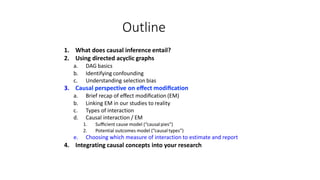Report
Share

Recommended
Recommended
More Related Content
What's hot
What's hot (17)
Multivariate analysis - Multiple regression analysis

Multivariate analysis - Multiple regression analysis
Confirmatory Factor Analysis Presented by Mahfoudh Mgammal

Confirmatory Factor Analysis Presented by Mahfoudh Mgammal
Similar to 5.3.4 reporting em
Similar to 5.3.4 reporting em (20)
Introduction to Econometrics for under gruadute class.pptx

Introduction to Econometrics for under gruadute class.pptx
MCA_UNIT-4_Computer Oriented Numerical Statistical Methods

MCA_UNIT-4_Computer Oriented Numerical Statistical Methods
MIKKAH MAE C. MANGAYAN- FS103.inferential-statisticspptx

MIKKAH MAE C. MANGAYAN- FS103.inferential-statisticspptx
Fundamental of Statistics and Types of Correlations

Fundamental of Statistics and Types of Correlations
Research methods 2 operationalization & measurement

Research methods 2 operationalization & measurement
Data Science - Part IV - Regression Analysis & ANOVA

Data Science - Part IV - Regression Analysis & ANOVA
More from A M
More from A M (20)
Recently uploaded
https://app.box.com/s/7hlvjxjalkrik7fb082xx3jk7xd7liz3TỔNG ÔN TẬP THI VÀO LỚP 10 MÔN TIẾNG ANH NĂM HỌC 2023 - 2024 CÓ ĐÁP ÁN (NGỮ Â...

TỔNG ÔN TẬP THI VÀO LỚP 10 MÔN TIẾNG ANH NĂM HỌC 2023 - 2024 CÓ ĐÁP ÁN (NGỮ Â...Nguyen Thanh Tu Collection
Mehran University Newsletter is a Quarterly Publication from Public Relations OfficeMehran University Newsletter Vol-X, Issue-I, 2024

Mehran University Newsletter Vol-X, Issue-I, 2024Mehran University of Engineering & Technology, Jamshoro
Recently uploaded (20)
General Principles of Intellectual Property: Concepts of Intellectual Proper...

General Principles of Intellectual Property: Concepts of Intellectual Proper...
TỔNG ÔN TẬP THI VÀO LỚP 10 MÔN TIẾNG ANH NĂM HỌC 2023 - 2024 CÓ ĐÁP ÁN (NGỮ Â...

TỔNG ÔN TẬP THI VÀO LỚP 10 MÔN TIẾNG ANH NĂM HỌC 2023 - 2024 CÓ ĐÁP ÁN (NGỮ Â...
Beyond_Borders_Understanding_Anime_and_Manga_Fandom_A_Comprehensive_Audience_...

Beyond_Borders_Understanding_Anime_and_Manga_Fandom_A_Comprehensive_Audience_...
Exploring_the_Narrative_Style_of_Amitav_Ghoshs_Gun_Island.pptx

Exploring_the_Narrative_Style_of_Amitav_Ghoshs_Gun_Island.pptx
HMCS Max Bernays Pre-Deployment Brief (May 2024).pptx

HMCS Max Bernays Pre-Deployment Brief (May 2024).pptx
Unit 3 Emotional Intelligence and Spiritual Intelligence.pdf

Unit 3 Emotional Intelligence and Spiritual Intelligence.pdf
Python Notes for mca i year students osmania university.docx

Python Notes for mca i year students osmania university.docx
ICT role in 21st century education and it's challenges.

ICT role in 21st century education and it's challenges.
On National Teacher Day, meet the 2024-25 Kenan Fellows

On National Teacher Day, meet the 2024-25 Kenan Fellows
5.3.4 reporting em
- 1. Outline 1. What does causal inference entail? 2. Using directed acyclic graphs a. DAG basics b. Identifying confounding c. Understanding selection bias 3. Causal perspective on effect modification a. Brief recap of effect modification (EM) b. Linking EM in our studies to reality c. Types of interaction d. Causal interaction / EM 1. Sufficient cause model (“causalpies”) 2. Potential outcomes model (“causal types”) e. Choosing which measure of interaction to estimate and report 4. Integrating causal concepts into your research
- 2. Potential Outcomes Model & EM • Calculate RRs from a real world study – Adjust for confounding – Consider role of bias – Quantify role of chance (e.g., confidence interval) • The RR for the relation between X and Y was different between people of Z=1 and Z=0 • This suggests heterogeneity in the measure of association between X and Y by values of Z • No connection back to causal interaction
- 3. Potential Outcomes Model & EM • Calculate ARs from a real world study – Adjust for confounding – Consider role of bias – Quantify role of chance (e.g., confidence interval) • The AR for the relation between X and Y was different between people of Z=1 and Z=0 • This suggests the presence of causal interaction between X and Z – Have to consider bias, control confounding, quantify role of random error and state assumptions
- 4. 39 Assessing EM on the additive scale using relative scale estimation methods • What if you want or need to estimate measures of association on a relative scale, but you want to assess interaction on the additive scale? • Estimate the Relative Excess Risk due to Interaction (RERI) RERI = RR11-‐RR10-‐RR01+1 NOTE: Recoding may be necessary for preventive exposures • RERI>0 implies that AR11 ≠ AR01+ AR10 – Interaction is present on the additive scale • RERI=0 implies that AR11 = AR01+ AR10 – Interaction is not present on the additive scale Read more: VanderWeele (2009). Sufficient Cause Interactions and Statistical Interactions. Epidemiology20:6-‐13.
- 5. What’s the best we can do to assess EM? • Be clear about whether we are purely assessing EM from a statistical perspective or if we intend to make causal inferences • Be thougheul about which scale we choose to assess interaction on • Attempt to minimize sources of bias and error in our studies
- 6. Outline 1. What does causal inference entail? 2. Using directed acyclic graphs a. DAG basics b. Identifying confounding c. Understanding selection bias 3. Causal perspective on effect modification a. Brief recap of effect modification (EM) b. Linking EM in our studies to reality c. Types of interaction d. Causal interaction / EM 1. Sufficient cause model (“causalpies”) 2. Potential outcomes model (“causal types”) e. Choosing which measure of interaction to estimate and report 4. Integrating causal concepts into your research